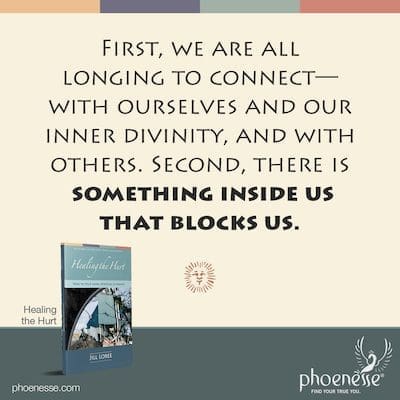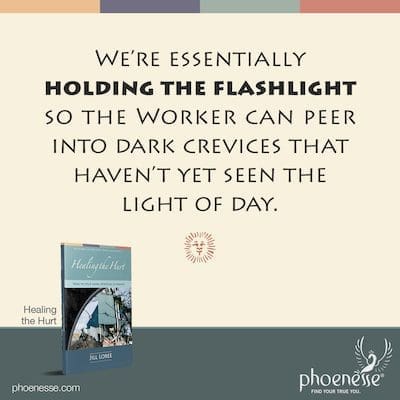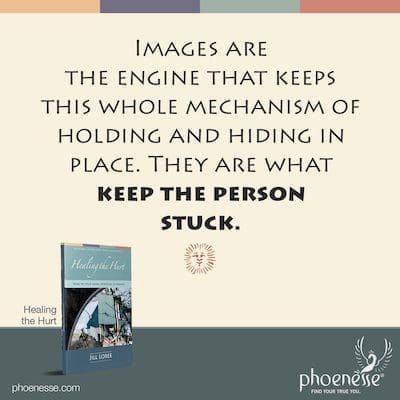- There’s Always a Story
- The Whole Point of the Work
- The Spiritual Aspect of the Work
- Just Breathing and Feeling
One of the few constants in life is that everything is always changing. Helper sessions are no different. As Workers, we need different things at different times, depending on where we are on our spiritual journey and what’s going on in our life. Sometimes we really need to be heard, so there’s a right time for talk. And we need to give voice to our inner dialog if we hope to untangle the knots. Most of the time, though, we need far fewer words than we think. As St. Francis of Assisi put it, “Preach the Gospel at all times; when necessary, use words.”

While Helpers should always be participating in some kind of supervision, new Helpers need a lot of oversight. As part of my Helpership training, I was required to work with a Worker for free, record the sessions, type up the transcripts, and then send them to my supervisor for review during my own supervision session. It’s hard to argue with the value of doing this. But the effort required to transcribe a one-hour session every two weeks for six months was onerous.
The biggest unintentional takeaway I got from this exercise was this: just stop talking. Because the longer I prattled on or let the Worker stay in their story, the more I had to type. I learned that, Yes, there is a need to share the Guide’s wisdom from time to time. But one can do this and be brief. Same for the Worker; the longer they go on with their story, the more they stay caught up in blame and building cases, and believing the way out is through the head. Reviewing session transcripts is a worthwhile exercise on all levels, and I highly recommend it for every aspiring Helper.
The main point is, there’s a need for some talking, to be sure. But if all that happens in a session is talk, talk, talk, we’re just circling the mountain. Instead, we want to find the opening where we can ride the railcar into the side of the mountain. For that’s where we’ll find the real dirt.
It’s also where the jewels are always hidden.
There’s Always a Story
The Guide gave us all these lectures about all the inner aspects of personal growth. In each of them, instead of encouraging us to do good in the world or be kind, the Guide continually leads us to exploring something much deeper: our negative intentions, our buried painful feelings, our destructive thoughts. Every single time, when we delve into these deeper layers of ourselves, we discover aspects of ourselves that aren’t so pretty.
Our work then is always to unravel the root ball at the source of our negativity. But we have to find it first. And the trail of crumbs that will take us there is our stories. The most common story subjects are about relationships with people—especially an intimate partner, a boss or a co-worker. In addition, we may also want to explore the Worker’s relationship to money, food, sleep, sex, and drugs and alcohol.
New Workers especially have lots and lots of stories, often with the main theme of “how the other guy did me wrong.” And that’s as it should be. That’s how our conflicts always surface so we can get a good hard look at them. So let’s not be too quick to discount the story. At the same time, our job as Helpers is to get off the story as soon as we can, without cutting anyone off.
Worker: (paraphrasing)… and then this happened…and then that happened… and then she said….and so I said….
Helper: I want to ask you to pause for a moment. You’re putting a lot out here for me to hear. Let’s just take a breath. How are you feeling in your body right now as you’re sharing this with me?
One of the things we might notice as the Worker is talking is that we’re losing the thread of what they’re saying; we’re having a hard time staying connected to the story. That’s always a good time to ask for a pause, because the same thing is likely happening with the Worker. Their energy might be literally lifting up out of their body as they are talking, and going into their head. (Read more in The Importance of Grounding.)
As Helpers, we want to notice everything we’re experiencing and keep bringing it into the session. Because it’s already in the room and it is giving us valuable information to be working with. Other examples include suddenly feeling tired (especially if we weren’t tired before the session), distracted or disengaged. Or we might start feeling a pain or tightness in our body or our breathing.
If the Worker is up in their heads, we want to bring them back down into their body. For that’s where the feelings reside that they are trying to avoid. That’s where the original pain is located. And it has magnetically attracted to the Worker a life experience that has scratched their old wound. This is what now makes their story so compelling to them.
Helper: What are you noticing in your body as you’re telling me this story?
Worker (holding their breath): I don’t know what I’m feeling.
Helper: So let’s just breathe together and come down into your body as you talk.
It’s not uncommon that the Worker will now touch into the feelings they have been trying not to feel. We can help them by opening up our own breathing and coming fully down into our own bodies. Because chances are, we may have followed them right on up into our heads. As we get ourselves grounded again, we can help the Worker by speaking out loud about how to do this.
Helper: Let’s open up our breathing and fully feel ourselves sitting in our chairs. We feel our sit bones on the chair and our feet on the floor; let your shoulders drop a little more with each exhale. Let the breath come all the way down into your belly. Open up your pelvis. Notice if there’s any tension in your body. Where do you notice tension?
Worker: In my lower back.
Helper: Let’s breathe into that tension in the lower back. Bring your breath into the tension. (Pause and breathe for a few breaths.) What are you aware of now?
What we often don’t realize is that it actually takes quite a bit of effort to keep our stories going. They are never in truth, because once we see the full truth of any situation, it relieves all tensions, resolves all disharmonies and we let go of our case. Until then, we have to tend our stories they way we would tend a sputtering fire. We repeat them to ourselves and tell as many others as we can, building cases and assembling our team of backers. For we must defend our position and assert our rightness.
We think we have to win. And this is a lot of work.
Once we come down out of our heads, we can find the source of where we are holding all that tension in our body. This is crucial for doing this work—getting into our bodies. Our reasoning mind is a valid and valuable part of the process, partly because it is holding the map. But the map of the mind is like a two-dimensional piece of paper. Once we get into our body, it’s like a relief map rising up from the depths of our being.
Ironically, once we get down into the body, now there’s not so much to talk about. The Worker needs to feel whatever they feel. In this book about helping, it is not possible or necessary to retell all of the Guide’s teachings about what has happened in the grand scheme of life to have brought this Worker to have painful life situations bumping against the residual pain of their inner wounds.
But what is important to point out here is that this block—this frozen ball of unfelt feelings—is the reason this Worker is sitting with us. It’s not the Big Reason, which would be their longing to know their real selves and to connect with their inner divinity. But this is what is standing in their way. This is what’s here now. So this is what we want understand, unwind, re-enliven and let go of.
Once we’ve helped guide the Worker to this frozen knot of feelings that’s under the story—we’ll discuss several different ways to go about doing the work in Down to Brass Tacks—we may find ourselves up against a wall. This is their inner wall of resistance that is part and parcel of not feeling our feelings. And it may not slide away so easily.
In fact, it probably won’t. The Worker is going to need some help, and this help can only come from their own Higher Self. This is the time for the Worker to pray. Whether out loud or silently to themselves, the Worker needs to actively ask for help from their Higher Self. They must do this so they can have the courage to feel these feelings and to open to the truth.
The Whole Point of the Work
Let’s pause here for a moment and point out a few things. First, there is no formula for how we do this work of Helping. There are as many creative ways to guide the Worker as there are creative thoughts that rise up from our guidance. That said, there are some tried and true methods that are typically effective and that I use in many of my sessions. And that’s what I’m sharing here for others to consider.
Other Helpers surely have many other ideas and approaches. As you go along, you’ll likely come up with a few others of your own. For example, I “invented” an approach using honor cords that I use all the time but have no idea if anyone else has also discovered this. (Read more in Working with Honor Cords.)

If we boil down all the Guide’s teachings, there are two essential things to realize. First, whether we know it or not, we are all longing to connect—with ourselves and our inner divinity, and with others. Second, there is something inside us that blocks us. This is the frozen block of unfelt feelings that is now trapped in our being and held in our body. It is an energy-consciousness bundle, so it is stuck energy that has faults as well as untrue beliefs, called images, associated with it.
If we open our arms a little bigger, perhaps we can see that there actually is one formula then that applies to every session: Our mission is to find the stuck place, and then pray. This is why we say this is spiritual work. Our goal, at this stage of the work, is to free our spirit, or Higher Self, from the dark Lower Self obstacles that are covering it.
The Spiritual Aspect of the Work
The one who hires us to be the Helper is the Worker’s Higher Self. For whenever we do the work of uncovering and healing our Lower Self, it is always an act of our Higher Self. Without this perspective, we can become too head-down about doing the work, constantly scrubbing the floors and losing sight of the fact that our goal is to enjoy living in a clean house.
Further, we can’t do this work without the help of both our Higher Self and another person. Until we have learned how to do this work, by working with a Helper for quite a long time, we can’t navigate our own selves to these stuck places by ourselves. The Lower Self is just too good at feeding us rationalizations and justifications for why our pain is not about us, why we should continue to believe our wrong thinking, and why it’s not safe to let go.

This is one of the those “both-and” things. We need to focus on the Lower Self so we can clear out the negativity and destructiveness that keep us from living from our Higher Self. And at the same time, we can’t do this work without the help of whatever threads of Higher Self we already have available. The stance of the Helper is to hold a healed presence so the wounded fragments of the Worker can come forward for healing.
We’re essentially holding the flashlight so the Worker can peer into dark crevices that haven’t yet seen the light of day. And while the Worker may need to lean on the strength of the Helper for some time, we do them a disservice if we don’t help them find their own inner light. More than that, we cripple them and prevent the whole point of doing the work from unfolding. As such, we need to be on guard for how our own ego may get overly involved in liking the way our Workers lean on us. This is why, as Helpers, we need to be in supervision so we can keep cleaning out our own closets.
Conscious connection with our Higher Self should be part of our attunement, our session, and our closing. We want to feel it as the walls of the container that hold both of us, the Helper and the Worker, during the session. Again, if the Helper starts to believe that they themselves—with only the limited resources of their ego—are running the show, things will eventually go south.
During the attunement, we invite spiritual support and guidance into the room. In some way, using whatever words feel right for the Worker, we want to acknowledge the presence of something greater than ourselves that is holding us during the session. All throughout the session, the Helper needs to keep opening their field of vision to invite in guidance and God.
For me, I continually, actively pray during a session, asking to be led and shown. I listen for the thoughts and words that come into me, and follow them the way one might look for breadcrumbs in the forest looking for a treasure. We Helpers are humans, so sometimes we don’t read the tealeaves quite right. The Worker is also full of resistance, so sometimes we need to change our tack. But always this is more like following the wind, rather than heading off with a mental concept of where we think the Worker should go based on roads we’ve travelled before.
Just Breathing and Feeling
We’ll know the Worker has hit this wall of difficult feelings when they start holding their breath. The origin of this strategy goes back to childhood. Every child will experience pain. That’s just the grand set-up of how it goes, as the Guide’s teachings explain. And when that happens, the child will try to cut off feeling those painful feelings. The universal way we do this is by holding our breath. So now, when we come back around to those exact same tender feelings, our automatic response for not feeling them will be to stop breathing.
As Helpers, one of our jobs is to be a breathing coach. When we see the Worker starting to resist their feelings, we remind them to “breathe.” In that moment, that’s really the only thing the Worker has to do—to breathe. When the breath comes into the body and meets the knot of unfelt painful feelings, they are re-experienced, felt and released. The energy is freed up and we get our life force back.

While all this is going on, it may not look like much is happening from the Helper’s perspective. But from the Worker’s chair, there may be a lot going on. Or there may be nothing. The Worker may have gone numb, which is an old habit we also all have done. If that happens, we just sit together and breathe for a moment. Or the Worker may not have fully been able to drop into their feelings yet, for whatever reason. Perhaps they are a new Worker and don’t really know how to do this yet. Or maybe there is some resistance there that is not quite ready to give way.
As their coach, we want to invite the Worker to feel their feelings as deeply as they can. It may take some time for them to trust that they won’t be annihilated by these feelings.This, of course is what the wounded inner child thought would happen, and which is why, as children, we cut these feelings off to begin with. This ties back to the black-and-white dualistic thinking of all children who believe that feeling pain is synonymous with death.
There is often shame associated with these sensitive areas as well. So it is helpful to verbally coach the Worker to keep going and stay with it. Due to transference (read more in What about Transference?), the Worker may have a tendency to want to appear “good” in the eyes of the Helper. Which means they don’t want the Helper to see their vulnerability, their negativity, their ugly bits.
Our assurance that it’s OK to feel whatever they’re feeling—including feelings of anger and rage that often cover over pain—and to “go as deeply with this as you can”, may go a long way to helping them empty the reservoir of toxic unfelt feelings.
In deep healing work, there will also often be waves of feelings. The Worker will ride through deep feelings and then come to the surface and feel calm. But with further exploration, another possibly deeper wave will likely come. Again, keep coaching that this is normal, and encouraging the Worker to ride these waves, going as fully into the feelings as possible. That’s how deep healing and release happens.
Our stance at this time is important. We need to allow some space for the Worker to have their own process, but we need to stay engaged with keeping the work moving forward. We want to leave some space and be quiet so the Worker can follow their own inner process, and then we might say: What are you noticing? or What are you aware of? Or Can you bring me into what you are experiencing in this moment? Otherwise the Worker might go numb or get lost or stuck, and not know how to proceed.
As the energy is freed up and able to flow, the consciousness trapped with it may release memories or associations. It is usually helpful for the Worker to give voice to their inner experience, so they can see the connections and patterns that surface.
Most importantly, the Helper needs to listen to what the Worker says, so they can help the Worker identify mistaken beliefs, called images. Images are the engine that keeps this whole mechanism of holding and hiding in place. They are the tools the Lower Self uses to keep the person stuck, so they must be discovered and dissolved.

There is something very powerful about mirroring a Worker’s words back to them. Obviously, this needs to be done with some skill. First, we literally want to use their same way of describing things as they do. Don’t modify or correct their words, or use a word we think would be more descriptive or helpful. We can use their own words to help them heal from their trauma in the same way they describe it.
The words to work with are the ones that are highly charged. As Helpers, we have to learn to feel into this and listen to our own guidance. Here’s where it also helps to have done a lot of work ourselves, so that we have our own felt sense available to us as Helpers. When we hear the Worker say a word or phrase that resonates loudly inside us, that’s the ones to say back to them, either in a question or a simple phrase.
Worker: There is this woman I work with and I just hate her. She is mean and bossy and thinks she can tell me what to do and when to do it. Every time I leave my desk, she does something cruel behind my back. I feel like I am being held hostage by her. I hate her.
Helper: She is cruel and you feel like you’re being held hostage. Does this feel familiar? Was there another time in your life that you felt this way, like you were being held hostage? (or Can you say more about feeling held hostage?)
Worker: Oh my God, she’s just like my sister. My sister treated me the same way. She was so mean to me. She made my life miserable. She’s the one who held me hostage.
Some other tips for finding out what’s happening inside a Worker is to look for any signs they are giving us. Their Higher Self has hired us, and its goal is to transform and heal the Lower Self. We can trust that the Worker is then, on some level, trying to help us help them.
Perhaps we notice how they are sitting, and we mimic that to see what their body is saying. We ask them about their crossed legs, or their crossed arms. What are these saying? If a toe or foot is jiggling or moving, we can ask what that is saying. Literally, although it may sound a bit corny, we want to let their body talk to us. The Worker, together with their body, will tell us what we need to know to help them.
If they won’t make eye contact we might say, “It seems you’re having a hard time looking at me. Can you say what that’s about?” If tears come up but no words want to come out, we can ask what the tears are saying. If we notice our throat or jaw is tightening up, we can ask the Worker how their jaw or throat is feeling; a great deal of tension is held in this area. If we’re feeling something new in the session, chances are good we’re feeling what they’re feeling, and this is good information for helping the Worker.
For the most part, what we need to do is slow things down. A session will sometimes feel like a ride on a roller coaster. The first part going up the big incline may go quite slowly and we may need to help move things in the right direction. But then once we clear the crest, we get out of the way, read the signs and follow cues, listening to our own guidance and praying to know how best to help.
The goal is not to have the Worker stuff their story, but to let it reveal where the Worker needs to go. Once they’re off and running, often the story isn’t really needed. If things go well and the Worker has plunged into their work, the Helper won’t ever hear how the story ended.
But we know that the arc is basically always the same: this happened, it hurts, and I don’t want to feel that. As soon as the Worker has accessed their frozen feelings, a big part of the story’s work is done. But there are several other important things we want to mine the session and the story for.


Next Chapter
Return to Healing the Hurt Contents


